Related Research Articles
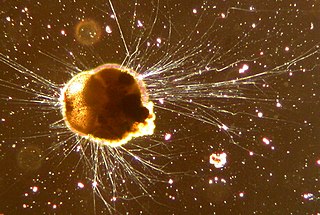
Foraminifera are single-celled organisms, members of a phylum or class of amoeboid protists characterized by streaming granular ectoplasm for catching food and other uses; and commonly an external shell of diverse forms and materials. Tests of chitin are believed to be the most primitive type. Most foraminifera are marine, the majority of which live on or within the seafloor sediment, while a smaller number float in the water column at various depths, which belong to the suborder Globigerinina. Fewer are known from freshwater or brackish conditions, and some very few (nonaquatic) soil species have been identified through molecular analysis of small subunit ribosomal DNA.

The aperture is an opening in certain kinds of mollusc shells: it is the main opening of the shell, where the head-foot part of the body of the animal emerges for locomotion, feeding, etc.
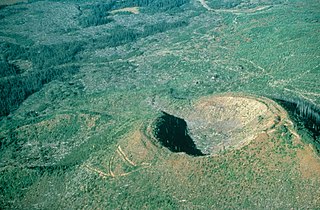
The Flourmill Volcanoes, also known as The Flourmills, are a small volcano range near the west boundary of Wells Gray Provincial Park in east-central British Columbia, Canada. Located north of Mahood Lake and west of the Clearwater River, they form part of the Wells Gray-Clearwater volcanic field.
Psammoactinia antarctica was an encrusting, colonial cnidarian in the family Hydractiniidae that lived in the Cretaceous Antarctic. Within its family, P. antarctica had the unusual ability to agglutinate sand and silt grants, incorporating them into the basal layer and pillars making up the wall of the chambers of its laminae. It encrusted gastropod shells inhabited by hermit crabs of the genus Paguristes.
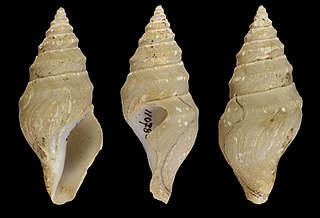
Bathytoma engonia is a species of sea snail, a marine gastropod mollusk in the family Borsoniidae.

Calliotropis pulchra is a species of sea snail, a marine gastropod mollusk in the family Eucyclidae.
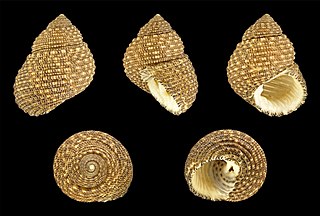
Euchelus atratus, common name the blackish margarite, is a species of sea snail, a marine gastropod mollusk in the family Chilodontidae.
Clavulina is a genus of aggulinated benthic foraminiferans with an elongate test. The early stage is triserial and triangular in section, the later stage uniserial and rectilinear, with angular to rounded section. In some species agglutinated walls have considerable calcareous cement. Septa are secondarily doubled as a result of imperforate floors, which are added as new chambers are formed. Walls contain fine bifurcating canaliculi within, openings of which are sealed internally by an inner organic lining, and externally by the imperforate surface layer of the wall. The aperture is interiomarginal in the early triserial stage, terminal and rounded in the adult.
Clavulinopsis is a genus of foraminifera from the Upper Cretaceous of the United States, included in the Textulariida. The type species is Clavulinopsis hofkeri Banner and Desai, 1985.
The Textulariacea is a superfamily of Middle Jurassic to Holocene agglutinated benthic textulariid Foraminifera. Tests are trochospiral, triserial, or biserial in early stages; later may be biserial or uniserial. Walls are agglutinated, made of gathered material cemented together and are canaliculate - contain micro-tubular cavities extending between the inner and outer surfaces.
The Valvulinidae is a family of Paleocene to recent benthic textulariid Foraminifera characterized by trochospiral tests in the early stage which may become uniserial in the later. Walls are of cemented agglutinated material and have cavities created by micro-tubules, i.e. are canaliculate. Apertures have a valvular tooth or flap, at least in early stage, but may become multiple and areal in the later stage.
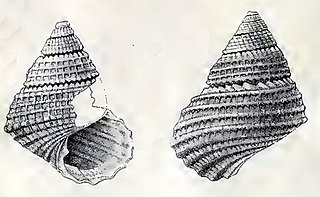
Perrinia cancellata is a species of sea snail, a marine gastropod mollusk in the family Chilodontidae.
Sigmoilinopsis is a genus of miliolid Foraminifera, with an ovate test, chambers one-half coil in length, arranged in rapidly changing planes in the early stage resulting in two spiralling series that appear sigmoid in section, gradually becoming planispiral in the adult. Walls are thick, porcelaneous but enclosing a large quantity of agglutinated quartz particles, sponge spicules, and shell fragments; the aperture terminal, rounded, with a small tooth.
Rotaliata is a class of Foraminifera characterized by tests that are exclusively multichambered, mostly planospiral or trochspiral, or derived from either. The aperture is commonly at the base of the apertural face, at least in early stages, but may be terminal, and single or complex. Test interior may be complex with secondary chambers and interconnecting canal system.
Spirocyclina is a genus of large forams, with a flat test as much as 10mm in diameter. Coiling is planispiral to slightly asymmetric and mostly involute, some becoming uncoiled with a straight final stage. The final whorl, or stage, has about 25 strongly arcuate chambers. Composition is of agglutinated matter, the outer layer of the wall imperforate. Chambers are subdivided into secondary chamberlets by internal structures. The aperture consists of a double row of pores on the apertural face. Anchispirocyclina and Martiguesia are among related genera.
Anchispirocyclina is a genus of agglutinated discoidal forams known from the upper Jurassic to the lower Cretaceous of Europe, north Africa, USA and Cuba.
Haurania is a genus of elongated, finely agglutinated benthic foraminifera included in the Spirocyclinidae. The test is free, starting with a brief planispiral coil followed by a straight uncoiled stage. The exterior is imperforate, the interior divided by radial septula or beams, perpendicular to the septa and outer wall. The aperture is cribrate, a series of openings on the terminal face.
Martiguesia is a genus of agglutinated benthic forams from the Upper Cretaceous (Santonian) of France. The test is free, the early stage planispirally coiled, becoming nearly straight during later growth. The agglutinated wall is externally imperforate, the interior with a coarse alveolar network. Chambers are subdivided and almost completely filled by irregular radial pillars. The aperture, cribrate.
Streptocyclammina is a genus of benthic forams with a flattened test from the Jurassic. The test usually starts off streptospiral hence the name, and becomes planispiral in the mature stage. Chambers are numerous per whorl, whorls become rapidly larger in peneropline fashion. Sutures between whorls are slightly indented, the periphery rounded. The wall is finely agglutinated, externally imperorate, internally with massive septa perforated by numerous apertures.
Vania is a genus of benthic forams from the upper Paleocene of Turkey with a large discoidal test up to 6.5mm in diameter. The microspheric test begins with a short planispiral stage, later chambers spreading successively from flabeilliform (fan-shaped) to reniform (kidney-shaped) and finally annular. The interior is subdivided by radial primary beams intercalated with secondary beams. The wall finely agglutinated, imperforate; aperture, two alternating rows of pores on the periphery.
References
- Pseudogaudryinidae Loeblich and Tappan, 1988, Foraminiferal genera and their classification.